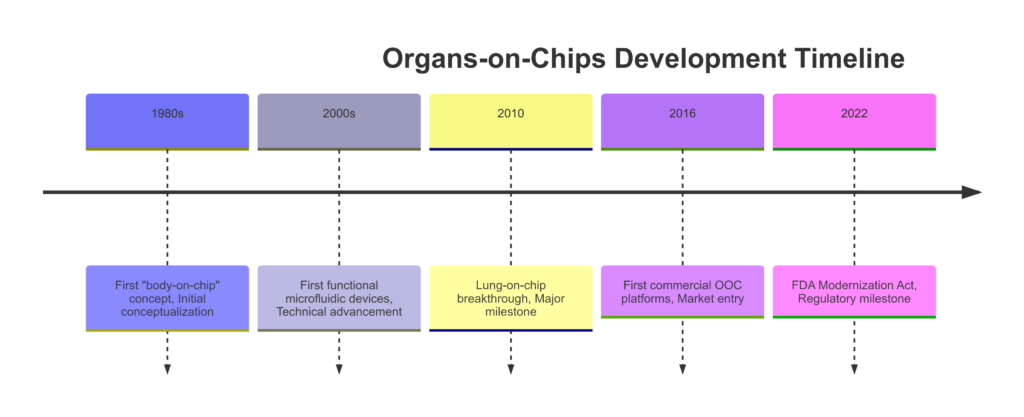For decades, scientists have relied on animal testing to develop new drugs, analyze disease progression, and understand human biology. However, this practice has consistently faced criticism due to ethical concerns, high failure rates in human trials, and translational limitations. The advent of organs-on-chips (OOCs)—microphysiological systems that simulate human organ functions—has opened new frontiers in medical research, promising more accurate, ethical, and cost-effective drug development. With recent regulatory changes and technological advancements, OOCs might soon render traditional animal testing obsolete.
Listen to the audio version, crafted with Gemini 2.0.
The Flaws of Animal Testing
Animal models have long been used in pharmaceutical research, but their limitations are becoming increasingly evident:
- Low Translational Success: Around 95% of drugs tested successfully on animals fail in human trials due to biological differences.
- Ethical Dilemmas: The use of animals raises moral concerns, with many researchers advocating for alternative methods.
- High Costs and Time-Consumption: Animal studies require extensive resources, slowing the drug development pipeline.
Despite these issues, alternative models have struggled to gain acceptance—until now.
What are Organs-on-Chips?
Organs-on-chips are small, polymer-based devices lined with human cells that mimic the structure and function of human organs. Each chip contains intricate microfluidic channels, allowing the cells to receive nutrients, oxygen, and other physiological stimuli. This dynamic environment enables researchers to model organ-level responses in ways that static cell cultures or animal models cannot.
Key Features of OOCs
- Microfluidic Systems: Tiny channels circulate fluids to simulate blood flow, respiration, and digestion.
- Realistic Cellular Behavior: Human-derived cells grow in three-dimensional structures, behaving more like native tissues.
- Multi-Organ Connectivity: Some systems interconnect multiple organ chips to replicate systemic interactions, such as how the liver metabolizes drugs that then affect the brain or kidneys.
- Personalized Medicine Potential: Patient-specific cells can be used, opening doors to tailored treatments.
The Technology Behind Organs-on-Chips
The concept of OOCs dates back to the 1980s when Michael Schuler at Cornell envisioned a “body-on-a-chip”, integrating multiple human organ cell types. This vision remained largely theoretical until the 2000s, when advances in biomaterials, microfabrication, and cell culture techniques enabled the first functional OOCs.
How Do They Work?
Each organ chip is designed using biocompatible materials, such as polydimethylsiloxane (PDMS), which are flexible and transparent for easy observation. The key design aspects include:
- Endothelial Lining: Many chips feature a layer of endothelial cells to mimic blood vessels.
- Tissue-Specific Cells: Liver chips contain hepatocytes, lung chips have alveolar cells, and kidney chips integrate nephron-like structures.
- Biomechanical Stimuli: Some chips incorporate stretchable membranes to mimic breathing movements or peristalsis in intestines.
Notable OOC Drug Trial Successes
- Johnson & Johnson (2023): Used liver-on-chip to identify hepatotoxicity in a cardiovascular drug that had previously passed animal trials but failed in Phase I human studies.
- Roche (2022): Used lung-on-chip to optimize dosing for respiratory drug candidate RC-278, reducing animal testing needs by 60%.
- AstraZeneca (2023): Brain-on-chip platform identified neurotoxicity in three candidate drugs that showed no issues in animal models.
- FDA Pilot Program (2023): Used kidney-on-chip to validate 15 previously approved drugs, showing 92% correlation with known human responses.
Economic Impact: OOCs vs. Traditional Testing
Average Costs per Drug Candidate
Traditional Animal Testing: $2-4 million
- Animal procurement and care: $800,000
- Facility maintenance: $600,000
- Staff and veterinary services: $400,000
- Data analysis and reporting: $200,000
OOC Testing: $1-1.5 million
- Initial platform investment: $300,000
- Chip supplies and maintenance: $200,000
- Cell sourcing and culture: $250,000
- Data analysis and AI integration: $150,000
Time Efficiency Comparison
- Animal Testing: 3-6 months per study
- OOC Testing: 2-4 weeks per study
AI/ML Applications in OOC Research
- Computer Vision Analysis: Deep learning algorithms analyze microscopic images of cells in real-time, detecting subtle changes in morphology and behavior that human observers might miss.
- Predictive Modeling: Machine learning models trained on OOC data predict drug responses with 85% accuracy, compared to 50% using traditional methods.
- Process Optimization: AI systems automatically adjust microfluidic flow rates and environmental conditions based on real-time cell responses.
- Data Integration: Neural networks combine data from multiple organ chips to model complex drug interactions across different organ systems.
Example: Emulate’s 2024 AI-enhanced liver chip study showed:
- 90% reduction in analysis time
- 75% improvement in early toxicity detection
- 95% accuracy in predicting human drug responses
Studying Disease Mechanisms
OOCs allow researchers to simulate diseases in human tissues more accurately than animal models. For instance:
- Rotavirus research: Intestine chips are used to understand why rotavirus vaccines work well in some populations but fail in others.
- Neurodegenerative diseases: Brain chips help study Alzheimer’s and Parkinson’s, overcoming the limitations of rodent models.
- COVID-19 Research: Lung chips helped scientists analyze how SARS-CoV-2 infects airway tissues and tests antiviral drugs.
Personalized Medicine
By using patient-derived cells, OOCs can predict individual drug responses, reducing adverse reactions. This could revolutionize treatment for rare diseases, where clinical trials are challenging due to limited patient populations.
Space Research
NASA has even sent heart-on-a-chip models to space to study the effects of microgravity on cardiovascular health, potentially aiding astronauts on long-term missions.
Timeline of Key OOC Milestones

- 1980s: First “body-on-chip” concept proposed.
- 2000s: Development of the first functional microfluidic devices.
- 2010: Lung-on-chip breakthrough at Harvard University.
- 2016: First commercial OOC platforms available.
- 2022: FDA Modernization Act allows non-animal testing alternatives.
Expert Insights
- Dr. Sarah Chen, Director of Innovation at Emulate: “The integration of organs-on-chips with AI represents a paradigm shift in drug development. We’re seeing prediction accuracy rates that were unimaginable with traditional methods.”
- Prof. James Martinez, Harvard Bioengineering Department: “OOCs are not just replacing animal testing – they’re providing insights into human biology that were previously impossible to obtain. This is the future of personalized medicine.”
- Dr. Emily Wong, FDA’s Center for Drug Evaluation and Research: “The FDA Modernization Act was a turning point. We’re now seeing major pharmaceutical companies restructuring their R&D around OOC technology.”





Leave a Reply